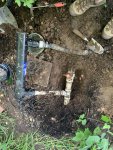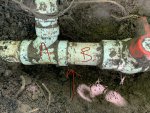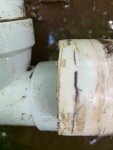I have a pond which came with the property when we bought the house. From what I can gather, it was originally installed maybe 20yrs+ ago. We have been in the house almost 9yrs.
I’m having a problem and i will try to keep it sufficiently detailed but reasonably brief.
Pond is approx 3600gal and consists of falls, collecting pool, stream and then main pond body at the bottom. I have 4 koi which are about 4-5yrs old and doing well so far.
From the pump (sits in skimmer box), buried PVC line runs alongside the pond to a UV Filter that is above ground (buried under fake rock) and then black flex PVC exits the UV filter and empties into the top of the falls.
Around April, my pump failed. Tsurumi 50PN2.25S - Just stopped working. I ordered a replacement. Since purchase/install in May, I have noticed the pump emptying the box at times and running dry. Pond water level dropping faster than it should. Blew capacitor on the pump and had to replace that. So I figured I had a leak somewhere...
I finally decided to investigate the leak last weekend. Noticed that the ground underneath the UV Filter was wetter than it should have been. Started digging...
I discovered that a joint in the PVC piping had separated (see photos) - it was completely loose and that’s where all the water was leaking out of the system. When I mark the joint line while intact, and then separate the joint (after some laborious digging), it looks like there is only about 1/4” mating in the joint. The depth to the stop is 1/2” so it’s only halfway in. I marked the sections A and B in the photo.
I would really appreciate any advice/thoughts on how to replace this. You can see from the photo that there are two ball-valves (NEITHER of which has been used since before I bought the house). The upper valve allows flow up into the UV filter, and the lower (deeply buried) valve - currently closed - I believe connects to a bulkhead fitting at the bottom of the falls.
Some questions/thoughts I had:
- How critical is a UV filter to a pond this size? If it’s not critical, maybe i can just bypass all the valves and re-plumb to run from the busted joint directly into the bottom of the falls?
- I don’t know why the outflow from the UV went through flexi hosing into the top of the falls - it is not the most visually appealing aspect of the pond (usually I hide it behind plants) and In order to use the Matala mats I have in the falls, i have to wedge the hose down between mat and walls
- if the UV is worth keeping, any tips on re-plumbing this gap?
It’s probably worth noting that my theory on how this joint got “insufficiently deep” is that we have a redbud tree next to the pond that was probably a small sapling when we moved in, and now has 9ish years of growth on it...I suspect that over time, the tree’s roots/growth slowly pushed aside the PVC that’s running from the skimmer, making it curve slightly and pull out of that joint.
Also probably worth mentioning that while I have zero experience working with PVC, I am pretty handy and am very much up to the challenge of fixing this myself.
Thanks in advance!
I’m having a problem and i will try to keep it sufficiently detailed but reasonably brief.
Pond is approx 3600gal and consists of falls, collecting pool, stream and then main pond body at the bottom. I have 4 koi which are about 4-5yrs old and doing well so far.
From the pump (sits in skimmer box), buried PVC line runs alongside the pond to a UV Filter that is above ground (buried under fake rock) and then black flex PVC exits the UV filter and empties into the top of the falls.
Around April, my pump failed. Tsurumi 50PN2.25S - Just stopped working. I ordered a replacement. Since purchase/install in May, I have noticed the pump emptying the box at times and running dry. Pond water level dropping faster than it should. Blew capacitor on the pump and had to replace that. So I figured I had a leak somewhere...
I finally decided to investigate the leak last weekend. Noticed that the ground underneath the UV Filter was wetter than it should have been. Started digging...
I discovered that a joint in the PVC piping had separated (see photos) - it was completely loose and that’s where all the water was leaking out of the system. When I mark the joint line while intact, and then separate the joint (after some laborious digging), it looks like there is only about 1/4” mating in the joint. The depth to the stop is 1/2” so it’s only halfway in. I marked the sections A and B in the photo.
I would really appreciate any advice/thoughts on how to replace this. You can see from the photo that there are two ball-valves (NEITHER of which has been used since before I bought the house). The upper valve allows flow up into the UV filter, and the lower (deeply buried) valve - currently closed - I believe connects to a bulkhead fitting at the bottom of the falls.
Some questions/thoughts I had:
- How critical is a UV filter to a pond this size? If it’s not critical, maybe i can just bypass all the valves and re-plumb to run from the busted joint directly into the bottom of the falls?
- I don’t know why the outflow from the UV went through flexi hosing into the top of the falls - it is not the most visually appealing aspect of the pond (usually I hide it behind plants) and In order to use the Matala mats I have in the falls, i have to wedge the hose down between mat and walls
- if the UV is worth keeping, any tips on re-plumbing this gap?
It’s probably worth noting that my theory on how this joint got “insufficiently deep” is that we have a redbud tree next to the pond that was probably a small sapling when we moved in, and now has 9ish years of growth on it...I suspect that over time, the tree’s roots/growth slowly pushed aside the PVC that’s running from the skimmer, making it curve slightly and pull out of that joint.
Also probably worth mentioning that while I have zero experience working with PVC, I am pretty handy and am very much up to the challenge of fixing this myself.
Thanks in advance!
Attachments
-
 5A7B5A20-E104-4500-8781-CB871CFB9435.jpeg370.5 KB · Views: 119
5A7B5A20-E104-4500-8781-CB871CFB9435.jpeg370.5 KB · Views: 119 -
 DB6C6715-EB5E-4E8F-8110-E8ED4B7793C6.jpeg298.4 KB · Views: 133
DB6C6715-EB5E-4E8F-8110-E8ED4B7793C6.jpeg298.4 KB · Views: 133 -
 D7B328F7-2E1D-4BFC-A24B-F39D1833A881.jpeg393.7 KB · Views: 108
D7B328F7-2E1D-4BFC-A24B-F39D1833A881.jpeg393.7 KB · Views: 108 -
 543AB334-2218-4C2B-AD31-1EC378B02A7D.jpeg242.9 KB · Views: 111
543AB334-2218-4C2B-AD31-1EC378B02A7D.jpeg242.9 KB · Views: 111 -
 FB0DE22F-C0A8-485C-A0D9-D1B828945C17.jpeg85.1 KB · Views: 99
FB0DE22F-C0A8-485C-A0D9-D1B828945C17.jpeg85.1 KB · Views: 99

